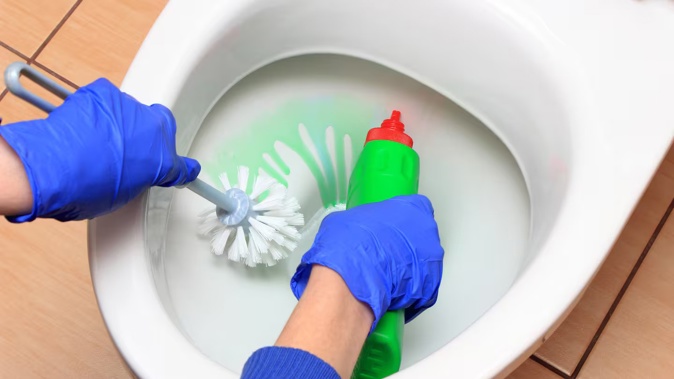
You probably know how to clean a toilet. It’s a chore most of us have done countless times. But knowing how to do something and knowing how to do something the right way are two different things.
“When you clean a toilet, not only do you clean the inside of the toilet where all the, you know, action happens,” says Bill Strang, the president of corporate strategy, e-commerce and customer experience at Toto USA, “you also want to make sure that you wipe down the sides and the rim of the bowl, and even the top of the tank lid.”
Here, Strang breaks down everything you need to know to get the job done.
How often to clean a toilet
Cleaning a toilet regularly is essential, but the definition of “cleaning regularly” will vary, based on what Strang calls “your use pattern”.
The primary toilet or toilets in your home – the ones that are used every day or several times a week – should be cleaned once a week. Less frequently used toilets, such as those in guest bathrooms, should be cleaned once a month. Staying on top of infrequently used commodes prevents mineral deposits and waterborne bacteria from building up, and it helps keep dust buildup at bay. And, of course, you should always clean toilets after someone in the household has been sick.
Choosing the right cleaner
There are a lot of toilet cleaning agents on the market, including gels, foams and drop-in tablets that promise to do all the work for you. We asked Lou Manfredini, a home expert at Ace Hardware, to break down the options and explain which ones are best for your needs, as well as what to avoid.
Liquid cleaners are the most common type of toilet cleaner and the most versatile – most can also be used on other bathroom surfaces and fixtures. Liquid cleaning agents come in a variety of formulas, including heavy-duty bleach-based cleaners and those formulated with gentler, plant-based ingredients.
Gel cleaners are ideal if you have hard water because their viscosity allows them to cling to the sides and under the rim of the bowl, providing more contact time to break down tough stains from mineral deposits.
Foam cleaners expand and cling to the exterior and bowl and, like gel formulas, they provide more contact time, making them well-suited for eliminating stubborn buildup, stains and bacteria. Many foaming bathroom cleaners also can be used on sinks, showers and bathtubs.
Drop-in cleaners, generally available in tablet or gel form, are placed in the tank or bowl, then released with each flush. “For those that may not need the bowl to be perfect, the drop-ins offer reliable cleaning – just keep a toilet brush handy to use once in a while,” Manfredini says. It’s worth noting that they clean only the bowl, so you will still need to clean the exterior parts of the toilet, including the seat and flusher.
Powder cleaners are applied directly to the bowl, then scrubbed with a toilet brush. They offer less coverage and clinging power than liquid, foam or gel cleaners but are typically more shelf-stable because they don’t contain water.
Heavy-duty cleaners, such as chlorine bleach or calcium, lime and rust remover, are useful after someone in the household has been sick with a highly contagious illness (think norovirus) or to eliminate stubborn mineral deposit stains. But these are not intended for everyday use. “Ultimately, the flushed water ends up in a water treatment plant and then circles back,” Manfredini says. “The fewer harsh chemicals we all use, the better.”
You also will need the following tools:
– Household gloves to protect your hands from bacteria, germs and chemical cleaning agents.
– Microfibre cloths for cleaning the exterior of the toilet, including the top of the tank, flusher, seat, base and the area around the toilet.
– A bowl brush.
- Paper towels (optional) for wicking away residue after cleaning.
How to clean a toilet
Strang provided step-by-step instructions for cleaning a toilet from top to bottom. And don’t forget the area around the base of the toilet, he says, where a lot of nasty buildup lurks.
Step 1: Dry dust the exterior
Use a dry microfibre cloth to wipe the entire exterior of the toilet, starting with the top of the tank and working down, finishing with the base and the floor around the toilet, to pick up dust, hair and other debris before introducing liquid cleaners. Pay special attention to the top of the tank and behind the seat, Strang says, two areas where dust and hair often lurk.
Step 2: Apply cleaner to the bowl
Doing this early in the process gives the product agent time to penetrate and break down the buildup inside the bowl while you clean the exterior.
Step 3: Clean the tank and flusher
Apply toilet cleaner to a microfibre cloth, or use a premoistened cleaning wipe (“Don’t flush wipes,” Strang says), and wipe the top and sides of the tank, including the flusher. Pay particular attention to buildup in joints or crevices.
Step 4: Clean the seat and ring
Close the toilet lid and use the same microfiber cloth to wipe the top side, then open it and clean the other side. Next, clean the top and underside of the seat, including the ring where the seat rests. Finally, Strang says, wipe the area around the bolts that secure the seat to the toilet.
Step 5: Clean the base or skirt, floor and walls
Continue to work downward, wiping the toilet base or skirt. Then wipe the walls and floor around the toilet to remove drips and splatters, which will make the area look cleaner and eliminate odour-causing bacteria. This step may seem unnecessary, but don’t skip it. “When you’re cleaning the toilet, that is not just the toilet you’re cleaning,” Strang says, “but also the area around the toilet.”
Step 6: Clean the bowl
Use a toilet brush to scrub the bowl. If the toilet is a box-rim style, pay particular attention to scrubbing the lip of the bowl, where a lot of bacteria and buildup tends to form. (Box-rim toilets flush water into the bowl from holes underneath the rim, whereas a rimless design flushes water around the entire bowl.)
Step 7: Dry the exterior (optional)
Use a clean, dry microfiber cloth or paper towels to dry the exterior of the toilet to remove any dust, lint or hair and to eliminate streaks and droplets left by liquid cleaning agents. It’s okay to skip this step, but doing it can give your clean toilet some added sparkle.
Take your Radio, Podcasts and Music with you









